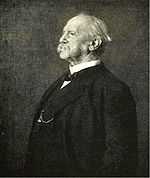Oscar Montelius
| Oscar Montelius | |
|---|---|
|
Oscar Montelius, painted by Emerik Stenberg (Photo of painting from the Swedish periodical Ord & Bild 1913) | |
| Born |
9 September 1843 Stockholm |
| Died |
4 November 1921 (aged 78) Stockholm |
| Nationality | Swedish |
| Fields | archaeology |
| Known for | seriation |
| Notable awards | Anders Retzius Medal (1913) |
Oscar Montelius (9 September 1843 – 4 November 1921) was a Swedish archaeologist who refined the concept of seriation, a relative chronological dating method. Seriation is the procedure of working out a chronology by arranging material remains of a cultural tradition in the order that produces the most consistent patterning of their cultural traits.
His impetus was at first to provide relative dates for artifacts in museum collections that often lacked rigorous records, by making comparisons with other artifacts within a comparable geographical area. Montelius’ method created a timeline specific to the location, based on material remains. Later, when combined with written historical references, objects could be provided absolute dates.
He took the three-age system (Stone age, Bronze age, Iron age), originally devised by Christian Jürgensen Thomsen to organize Danish museum collections of archaeological materials, and sub-divided it further. He divided the Neolithic in Scandinavia into four numbered periods, I-IV, and the Nordic Bronze Age into six I-VI. He was the first to establish that the numerous Swedish petroglyphs were from the Nordic Bronze Age, by comparing axes portrayed in the petroglyphs with archaeological finds. Further he supported Thomsen's typology of gold bracteates from the migration period.
By taking calendrical dates from the recently deciphered hieroglyphics of Ancient Egypt, Montelius employed a complex system of cross-dating through typologies and associated finds to apply absolute dates to archaeological finds and features all over Europe.
His diffusionist theories were eventually displaced by more complex views of cultural interaction but following refinement his system of sub-divisions is still effectively in use. Montelius was made a member of the Swedish Academy in 1917.
He and his wife, the feminist Agda Montelius, are buried in a "stendös" grave (a type of grave that was common in Sweden during the Nordic Bronze Age) in Norra begravningsplatsen in Solna, Sweden.
Strindberg on Montelius
The playwright August Strindberg, a contemporary of Montelius, held his work in low regard and satirized archaeology and Montelius' typological work in particular, in his De lycksaliges ö (published in Svenska öden och äfventyr 1882) Montelius and his colleagues are compared to button collectors who typologize buttons in accordance to uses, number of holes, etcetera, founding the science of buttonology (knappologi). The typologists then go on to demand professor chairs for themselves, considering the science highly important.
Further reading
- Remains from the Iron Age of Scandinavia. Haggström, 1869.
- Om lifvet i Sverige under hednatiden. Norstedt, 1873.
- La Suède préhistorique. P. A. Norstedt, 1874.
- Tombe ed antichità galliche in Italia. Salviucci, 1877.
- The Civilisation of Sweden in Heathen Times. Macmillan and Co., 1888.
- La civilisation primitive en Italie depuis l'introduction des métaux, Part 1. Imprimerie royale, 1895.
- Das Museum vaterländischer Alterthümer. Häggström, 1897.
- Die Chronologie der ältesten Bronzezeit in Nord-Deutschland und Skandinavien. F. Vieweg and Son, 1900.
References
| Cultural offices | ||
|---|---|---|
| Preceded by Vitalis Norström |
Swedish Academy, Seat No.18 1917-1921 |
Succeeded by Albert Engström |
External links
| Wikisource has original works written by or about: Oscar Montelius |
- Oscar Montelius
- "Oscar Montelius." Encyclopædia Britannica. Encyclopædia Britannica Online. Encyclopædia Britannica, 2011. Web. 8 May. 2011.
|
